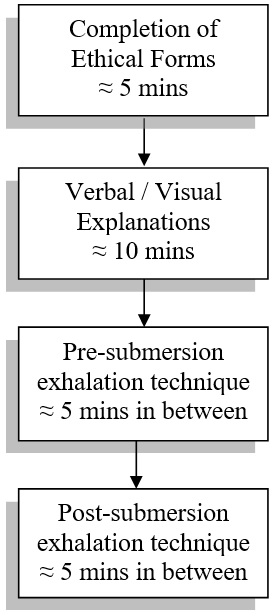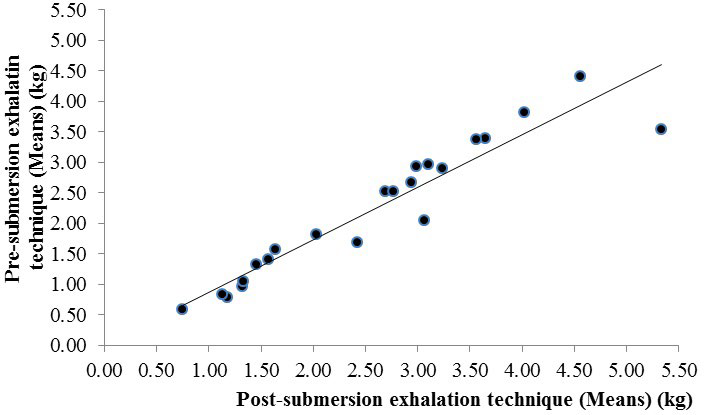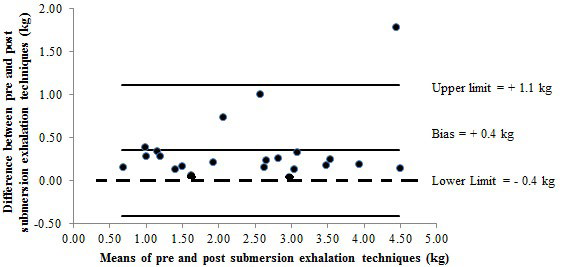INTRODUCTION
Hydrostatic weighing can be demanding on the participant even after an initial period of familiarisation.1,2,3 For instance, the weighing procedure requires the participant’s cooperation whilst totally submerged in water.4 Being submerged can be a daunting experience for participants, particularly as they are required to exhale maximally whilst keeping as still as possible in a crouched seated position.4,5 These procedural difficulties were reported by Jüurimäe et al4 Demura et al2 and Slater et al3 who suggested that some participants were unable to maximally exhale due to uncertainty, and in some cases apprehension, induced by the required technique. In other words, this apprehension can result in the deliberate retention of surplus air in the lungs, thereby influencing measurement results, making collected data unreliable.6,7,8
The ability of the primary investigator to achieve complete compliance should improve the criterion validity of the hydrostatic weighing procedure.3,4 Hence, the requirement for complete compliance has resulted in researchers using various body positions and breathing manoeuvres that improve comfort and reduce apprehension for participants. Therefore, the aim of this methodological investigation was to determine the agreement between two commonly used maximal exhalation techniques for the hydrostatic weighing procedure.
METHODS
Twenty-two volunteers (n=10 male and n=12 female) were recruited from the University of Gloucestershire, School of Sports and Exercise, (BSc Hons) undergraduate programmes. All participants were over 18 years of age and all were free from disease, illness or injury (ᵡ±s; age=20.5±1.7 years, body mass=68.7±1.5 kg and stretched stature=172.0±8.3 cm) (see Table 1). Ethical approval for the methodological procedures was granted from the University of Gloucestershire’s Research Ethics Committee. All participants were given an informed consent form and understood their involvement and their right to withdraw. Consent was secured with a participant signature.
| Table 1. General Summary (ᵡ±s) Characteristics for (n=22) Participants. |
|
Variables
|
ᵡ±s |
Range
|
|
Age (yr)
Body mass (kg)
Stretched stature (cm)
Vital Capacity (mean) (l)
|
20.5±1.7
68.7±1.5
172.0±8.3
4.33±1.1 |
18.0-25.0
53.8-116.6
156.8-188.4
2.48-7.38
|
|
Exhalation Techniques
Pre-submersion (mean) (kg)
Post-submersion (mean) (kg)
|
0.95±1.4
1.40±1.3
|
0.75-5.33
0.65-5.03
|
Participants undertook two separate underwater weighing technique trials in a cross-over order with 5 minutes break between each trial. One trial involved a ‘pre-submersion exhalation’ technique and the other trial involved a ‘post-submersion exhalation’ technique. Each trial comprised of ten attempts at the technique as illustrated in Figure 1.
Figure 1. Standardised Testing Schedule.

For both trials participants sat in an upright position, applied a nose clip and held the ropes of the underwater tank seating system having weights. They were submerged to chin level via a hydraulic hoist that was operated by the primary investigator. Rest intervals between each measurement attempt were given at the discretion of the primary investigator and were dependent on whether the participant felt able to repeat the measurement attempt.
Pre-Submersion Exhalation Technique
The rate of breathing for each participant was called by the primary investigator and comprised of three cycles of normal inhalation and exhalation. On the third cycle the primary investigator asked the participant to take a maximal inhalation immediately followed by a maximal exhalation. The participant was then instructed to blow out maximally just below the surface of the water to avoid temptation of inhalation prior to submerging the head. When the participant felt that they could no longer force any more air out of their lungs, they were instructed to submerge their head fully and keep as still as possible underneath the water. Once submerged, the primary investigator took the measurement of the participant’s body mass in water (kg) from the wall mounted digital weighing scale adjacent to the hydrostatic weighing tank. Following the measurement reading, the primary investigator rapped loudly on the side of the tank thereby instructing the participant to return to the surface.
Post-Submersion Exhalation Technique
Participants were asked to initiate their own breathing rate and when ready, take a small inhalation, lean forwards and submerge themselves fully. Once underwater and keeping as still as possible the participant exhaled maximally. The primary investigator watched for the ending of exhalation bubbles and took the measurement of the participant’s body mass in water (kg) from the wall mounted digital weighing scale adjacent to the hydrostatic weighing tank. Following the measurement, the primary investigator rapped loudly on the side of the tank instructing the participants to return to the surface. The agreement between the average underwater weights (from ten attempts) for each participant across both measurement techniques was illustrated in the form of a scatter plot (Figure 2). The bias, residual error and heteroscedasticity between the two techniques are illustrated (Figure 3) to determine whether significant differences (underreporting) were evident between the exhalation techniques.
Figure 2. Comparison of Pre-Submersion and Post-Submersion Exhalation Techniques for Underwater Weighing.

Figure 3. Bland and Altman Plot Showing Bias and 95% Limits of Agreement for the Pre-Submersion and Post-Submersion Exhalation Techniques for Underwater Weighing

RESULTS
Results from the pre-submersion exhalation technique revealed that four participants were unable to successfully carry out a single attempt and the remaining participants were only able to complete a mean average of four underwater weighing attempts. Participant’s claimed that this technique was uncomfortable and stressful, thereby questioning the usefulness of this measurement. Conversely, the primary investigator found that all participants using the post-submersion exhalation technique were able to perform a mean average of nine underwater weighing attempts. All participants albeit subjectively, claimed that this measurement was far more comfortable. When comparing body mass in water values between the two exhalation techniques, results indicated systematic bias (lower value for post-submersion technique). There was a significant difference in body mass values between pre-submersion technique (Mean±SD=2.6±1.2 kg) and postsubmersion technique (2.2-1.1 kg), t21=4.19, p<0.01 (Figures 2 and 3).
CONCLUSION
Whilst the process of obtaining underwater weight via hydrostatic weighting can vary according to laboratory and researchers, it is crucial to reduce measurement error with the measurement technique.7,8,9 Results from this methodological investigation suggest that the post-submersion exhalation technique was associated with less apprehension, greater comfort and reduced water disturbance than the pre-submersion method, thus resulting in more reliable values for underwater weight. Since higher values for underwater weight are a reflection of more a complete exhalation cycle, it can be concluded that the post-submersion exhalation technique was the preferred technique for all future hydrostatic weighing testing in the future.
CONFLICTS OF INTEREST
The authors declare that they have no conflicts of interest.








